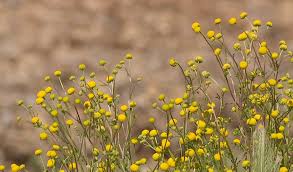















Annual Sowthistle
An erect fleshy annual 1 to 4 feet high. All but the upper leaves are deeply lobed with 1 to 3 lobes along each side. Flower heads are numerous and pale yellow, 1⁄4 to 3⁄4 inch wide. The seeds are flat and ribbed lengthwise with a tuft of fine hairs which allows wind-borne dissemination.
Bermuda Grass
A wiry perennial with long, slender, creeping rhizomes and stolons. Stolons spread laterally over the ground, rooting freely at any node, above or below ground. The seed heads are upright and bear a group of 3 or 7 spikes up to 2 inches long. Bermudagrass actively grows with hot weather approximately April through the first frost.
Coast Fiddleneck
Coast fiddleneck is a native winter annual with upright stems, and
inhabits agricultural land and other disturbed areas. This weed’s fruits can be toxic to livestock when consumed in quantity. Poisonings most often occur when livestock ingest contaminated grain or feed. It can reach up to 4 feet (1.2 meters) tall. Leaves are alternate to one another along the stem and are stalkless, except for the short-stalked lower leaves. Leaves are long and narrow to spear shaped with smooth edges and sparsely to moderately covered with stiff, bristly hair.
Common Mallow
Also called buttonweed, cheeseweed. Common Mallow is an annual, winter annual or biennial with stems geerally low spreading, the branches erect from 2 to 20 inches long. Seedling plants have heart-shaped embryonic leaves. True leaves have large, lobed leaves with a V-notched base. Flower heads are yellow, often drying blue. Each flowering head has 6 to 30 flattened fruits, bristly near the summit.
Crabgrass
Crabgrass is an annual weed that grows vigorously dry and hot conditions. Its seeds begin to sprout in mid-spring, when the soil temperature reaches around 55 degrees. Crabgrass gets its name because it grows low to the ground with stems that radiate out from the center of the grass clump, resembling crab legs. This weed thrives on stressed areas of your yard, like dried-out lawns, thin patches, and sun-scorched areas.
Dandelion
Dandelions are a broadleaf perennial that can grow in any soil and are most numerous in full sunlight. In the early spring, new sprouts will emerge from the taproot, which can be 2 to 3 feet deep in the soil. They grow yellow flowers that mature and turn into white puffballs that contain seeds which spread with the wind to other lawns. Even the most well groomed yard will have an occasional dandelion. They are difficult to completely eliminate and the entire plant (root and all) needs to be removed or they can grow right back.
Hog Potato
A low growing weak-stemmed perennial up to 1 foot tall, that reproduces from seed or underground tubers. Leaflets are oblong from 1/8 to 1/4 inch long and with glandular dots. Flowers are pea-like, yellow or red-orange, about 1/2 inch long. Hogpotato is a native weed of the Southwest and is found in large colonies growing in alkaline soil along roadsides and ditch banks.
London Rocket
A winter annual, it is erect, usually 1 ½ to 2 feet tall. Stems and leaves are smooth. Flowers are small, yellow and borne on slender stalk, with small clusters at stem tips.
Nutsedge
Nutsedge is a perennial, grass-like lawn weed. Although it’s sometimes called nutgrass, it’s not technically a grass. It’s a sedge. Its leaves are grasslike and yellow-green, and the spiky flower or seed head is yellow. Yellow nutsedge can be distinguished from good grasses by its V-shaped stem. Its leaves are bright green and have a waxy appearance, and grows faster than many lawn grasses, so it is often noticed when it outgrows the surrounding grass. It will also remain a bright green in summer when surrounding lawn grass may be a lighter green. Nutsedge thrives in low spots and high moisture areas that drain poorly, but can occur in drier sites as well.
Prickly Lettuce
Also called wild lettuce. Prickly lettuce is a biennial or winter annual, from a large taproot, with milky juice, reproducing only by seeds. Leaves alternate, twisted at the base to lie in a vertical plane, prickly on the lower side of the midrib, clasping the stem with two angled or earlike lobes.
Puncture Vine
This plant produces spiny seed burs that are sharp enough to cause severe pain to feet and hooves. They are sturdy enough to puncture rubber or leather, which means they can poke through shoe soles or bike tires. The spiny burs are harmful to agricultural crops, such as wool and hay. Puncture vine is adapted to grow in dry climate locations in which few other plants can survive.
Redstem Filaree
This weed is a winter annual or biannual with stems between 1 inch and 2 feet long. Their stems are either spread out or erect, generally from a rosette. The -leaves are divided into narrow feather-like or lobed or toothed segments. Both the leaves and the stems are hairy. Its flowers are a purplish/pink color, and are usually borne in clusters of 2 or more.
Ridgeseed Spurge
This weed is a summer annual with many branches that form circular mats. The stems are hairless, and branch heavily from the base and upper branches, forming dense spreading mats up to 12 inches across, or somewhat open and ascending in surrounding grasses. Leaves and stems exude milky sap when broken.
Russian Thistle
This weed, after drying out, is also known as a tumbleweed. Russian thistle is a bushy annual that grows 6 to 36 inches tall and reproduces from seed. Stems are usually red or purple striped. Flowers are green and hard to recognize near the upper leaves. Seeds are spread as mature plants break off at ground level and tumble with the wind. One plant typically produces about 250,000 seeds, which may remain viable for one year. Rapid germination and seedling establishment can occur with very limited amounts of precipitation. It is often found in dryland fields but is also common on disturbed and overgrazed rangeland.
Stinknet (Globe Chamomile)
Globe Chamomile is an annual weed growing up to 2 feet or more. It is recognized by
its dark green “carrot like” leaves and unique rounded yellow flowers. The leaves have a pungent odor. Globe Chamomile sprouts & grows from late November until the end of January. It begins to flower in early January & quickly begins seeds setting by early February. In years of sufficient winter moisture, it can go through up to 3 generations between November and the end of April.
Yellow Starthistle
Annual, 2 – 3 feet tall, with rigid branching, winged stems covered with a cottony pubescence. Basal leaves are deeply lobed while upper leaves are entire and sharply pointed. Flower heads are yellow, located singly on ends of branches, and armed with sharp straw-colored thorns up to 3⁄4 inch long.
